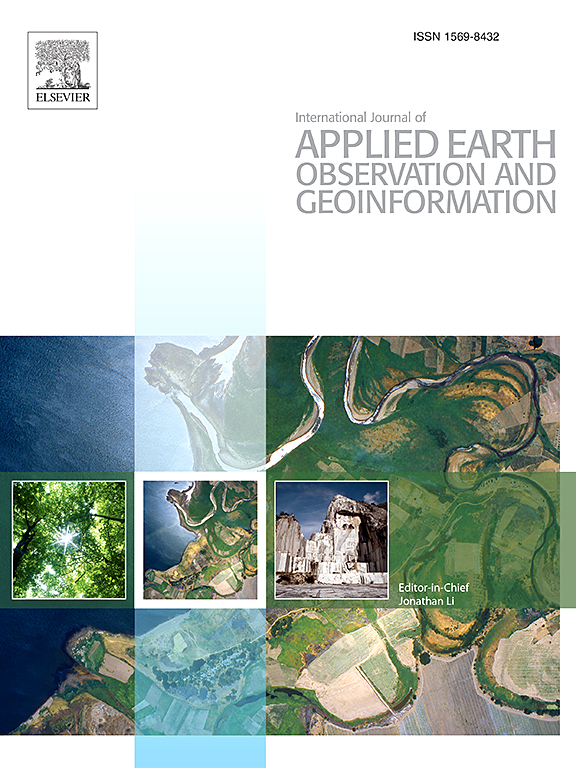GCT-GF: A generative CNN-transformer for multi-modal multi-temporal gap-filling of surface water probability
IF 8.6
Q1 REMOTE SENSING
International journal of applied earth observation and geoinformation : ITC journal
Pub Date : 2025-05-29
DOI:10.1016/j.jag.2025.104596
引用次数: 0
Abstract
Spatial and temporal data gaps present a significant challenge to high-frequency surface water mapping using satellite imagery. Utilizing observations from temporally close periods and multi-modal sensors for gap-filling is of critical importance. However, discontinuous pixel values inherent to conventional water maps hinder the application of deep learning methods, which are effective and popular for relevant studies. In this study, a novel approach, termed “gap-filling of surface water probability”, is introduced to achieve seamless surface water mapping. A new fused dataset tailored for this purpose was constructed, consisting of paired synthetic aperture radar (SAR) and surface water probability data with a 10-meter spatial resolution at a 10-day interval. A Generative CNN-Transformer (GCT) for Gap-Filling (GF) of surface water probability, GCT-GF, was then proposed to integrate the strengths of convolutional neural networks (CNNs) and transformers to reconstruct gapless water probability images from multi-modal and multi-temporal data. The GCT-GF employs a coarse-to-fine structure: information from different time points is initially aggregated using a branched gated inpainting module, followed by refinement and alignment of the coarse output under target SAR guidance. For adversarial learning, a branched SN-PatchGAN discriminator is introduced to adapt to the multi-temporal input. The results show that the GCT-GF surpasses the state-of-the-art relevant methods in quantitative metrics and visual perception. The fusion of multi-modal, multi-temporal inputs obvious enhance the gap-filling performance across varying gap ratios. Applied to Baiyangdian, Poyang Lake Basin and Qinghai Lake, GCT-GF demonstrates its high reliability on large scale scenes.
GCT-GF:地表水概率多模态多时间间隙填充的生成式cnn -变压器
空间和时间数据差距对利用卫星图像进行高频地表水制图提出了重大挑战。利用临时封闭周期的观测数据和多模态传感器来填补缺口至关重要。然而,传统水图固有的不连续像素值阻碍了深度学习方法的应用,而深度学习方法在相关研究中是有效和流行的。在这项研究中,引入了一种新的方法,称为“地表水概率的间隙填充”,以实现无缝地表水制图。为此构建了一个新的融合数据集,包括配对的合成孔径雷达(SAR)和地表水概率数据,空间分辨率为10米,间隔为10天。在此基础上,提出了一种用于地表水概率Gap-Filling (GF)的生成式CNN-Transformer (GCT -GF)方法,将卷积神经网络(cnn)和transformer的优势结合起来,从多模态、多时间点数据中重建无间隙水概率图像。GCT-GF采用了一种从粗到精的结构:来自不同时间点的信息最初使用分支门控绘制模块进行聚合,然后在目标SAR引导下对粗输出进行细化和对齐。在对抗学习中,引入了分支的SN-PatchGAN鉴别器来适应多时间输入。结果表明,GCT-GF在定量指标和视觉感知方面都优于目前最先进的相关方法。多模态、多时间输入的融合显著提高了不同间隙比下的间隙填充性能。在白洋淀、鄱阳湖流域和青海湖的应用表明,GCT-GF在大尺度场景下具有较高的可靠性。
本文章由计算机程序翻译,如有差异,请以英文原文为准。
求助全文
约1分钟内获得全文
求助全文
来源期刊

International journal of applied earth observation and geoinformation : ITC journal
Global and Planetary Change, Management, Monitoring, Policy and Law, Earth-Surface Processes, Computers in Earth Sciences
CiteScore
12.00
自引率
0.00%
发文量
0
审稿时长
77 days
期刊介绍:
The International Journal of Applied Earth Observation and Geoinformation publishes original papers that utilize earth observation data for natural resource and environmental inventory and management. These data primarily originate from remote sensing platforms, including satellites and aircraft, supplemented by surface and subsurface measurements. Addressing natural resources such as forests, agricultural land, soils, and water, as well as environmental concerns like biodiversity, land degradation, and hazards, the journal explores conceptual and data-driven approaches. It covers geoinformation themes like capturing, databasing, visualization, interpretation, data quality, and spatial uncertainty.
 求助内容:
求助内容: 应助结果提醒方式:
应助结果提醒方式:


